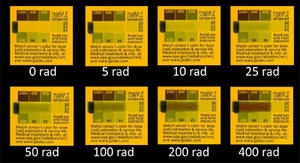Radiation threatsFree radiation monitors handed out in South Carolina
Ionizing radiation, the most energetic form, is capable of removing electrons from atoms and damaging the DNA within living cells; widespread panic caused by a dirty bomb, small nuclear device, or nuclear fallout would leave people questioning whether or not they were exposed to a lethal dose of ionizing radiation; the RadSticker is an inexpensive citizen’s dosimeter which could minimize panic in the event of a radiological incident

RadStickers exposure guide // Source: disasterpreparer.com
Widespread panic caused by a dirty bomb, small nuclear device, or nuclear fallout would leave people questioning whether or not they were exposed to a lethal dose of ionizing radiation. Representatives of the National Health Physics Society (NHPS) have met with local emergency managers in South Carolina and distributed computer chip-sized radiation monitors, or dosimeters, free of charge. The monitors, or RadStickers, were created by DoD in the wake of 9/11 to prevent first responder casualties in the event of nuclear or radiological terrorism.
There are different forms of radiation surrounding us at any given time — radio waves, X-rays, or cosmic radiation from space — but ionizing radiation, the most energetic form, is capable of removing electrons from atoms and damaging the DNA within living cells.
Living tissue in the human body can be harmed by ionizing radiation as the body attempts to repair the damage, which can often be too severe or widespread, causing mistakes in the natural repair process.
The RadSticker is an inexpensive citizen’s dosimeter which could minimize panic in the event of a radiological incident where people would demand testing or medical treatment, which would do little to cure or minimize the effect of a dose of lower than 25 rad. RadStickers can detect as little as 5 rad to 1,000 rad.
NHPS representatives are visiting police and fire stations in Charleston, Berkeley, and Dorchester counties to train and equip officials against the effects of nuclear terrorism and “dirty bombs”.
Steve Jones of the NHPS said that when the device is exposed to radiation, a portion of the yellow monitor will begin to darken depending on the level of exposure. At a weight of 0.2 grams, the monitors are small enough that someone can carry them in their wallet or purse unnoticed.
A warning on the monitor reads “sensor is always active and instantly develops color when exposed to gamma/X-ray.”
“You want to carry it ‘24-7,’ ” Jones said, although the service life of a monitor is 1-5 years.
Efforts to monitor domestic and foreign weapons tests, accidents, and other radiological events, are done by the Environmental Protection Agency’s (EPA) RadNet program, formerly known as the Environmental Radiation Ambient Monitoring System (ERAMS). The program is a national network of monitoring stations that regularly collect air, precipitation, drinking water, and milk samples for analysis of radioactivity and to ensure the protection of public health.
More than 2,500 of the monitors were handed out to police and emergency services departments from Folly Beach to Ladson, South Carolina, last week.
